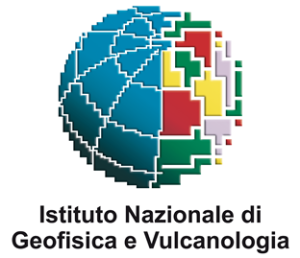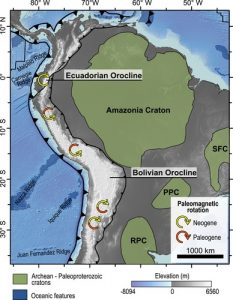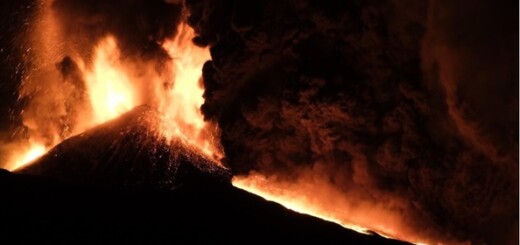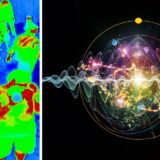Scoperta l’origine della forma arcuata delle Ande

Attraverso l’analisi di nuovi dati paleomagnetici del territorio dell’Ecuador sono state evidenziate le rotazioni della Cordigliera Occidentale che si riflettono nella forma arcuata della catena andina, ed è stata messa in luce la natura della Valle Inter-Andina

Roma, 14 settembre 2021 – Un team di ricercatori dell’Istituto Nazionale di Geofisica e Vulcanologia (INGV), dell’Università ESPOL di Guayaquil in Ecuador e dell’Università di Toronto in Canada, hanno dimostrato che la Cordigliera Occidentale dell’Ecuador ha subito una rotazione oraria di circa 20° negli ultimi 10 milioni di anni.
Confrontando questo risultato con precedenti ricerche lungo le Ande, hanno scoperto che la tipica forma convessa delle Ande in Ecuador è stata generata da rotazioni paleomagnetiche di verso opposto, orario ed antiorario, dei due lembi dell’arco. Il processo di orogenesi ha quindi determinato l’arcuatura della catena montuosa che precedentemente aveva una forma più rettilinea.
Lo studio Significance of northern Andes terrane extrusion and genesis of the Interandean Valley: Paleomagnetic evidence from the “Ecuadorian Orocline” è stato pubblicato nella rivista ‘Tectonics’ dell’AGU.
Le Ande rappresentano una delle più spettacolari catene montuose del globo. Corrono per ben 8.000 km lungo il margine Ovest della placca sudamericana, dai Caraibi alla Terra del Fuoco. Si deve la loro origine alla subduzione (ovvero, allo sprofondamento di una zolla litosferica al di sotto di quella immediatamente adiacente) che si protrae da almeno 200 milioni di anni tra i settori oceanici di varie placche (Caraibi, Nazca, Placca Antartica) al di sotto della placca sudamericana.
Nuovi dati paleomagnetici sono stati ottenuti da ricercatori dell’INGV (Gaia Siravo e Fabio Speranza) in collaborazione con ricercatori dell’Università ESPOL di Guayaquil (Ecuador) e dell’Università di Toronto (Canada).
Durante una campagna di tre settimane nell’ottobre 2019, che per l’INGV è stata condotta da Gaia Siravo e Fabio Speranza, sono stati prelevati oltre 300 campioni orientati nella Cordigliera Occidentale e Reale dell’Ecuador, andando a costituire il primo dataset paleomagnetico mai ottenuto da quest’area. I campioni, provenienti da rocce vulcaniche di età compresa tra 10 e 40 milioni di anni sono stati portati a Roma e analizzati nel Laboratorio di paleomagnetismo dell’INGV. Questi dati hanno permesso di evidenziare le rotazioni che hanno accompagnato gli eventi orogenici di formazione della catena andina.
I ricercatori hanno, inoltre, battezzato l’arco delle Ande ecuadoriane come “Ecuadorian orocline” e hanno scoperto ulteriori implicazioni sulla sua formazione.
“Dai nostri studi è emerso che che la sua geometria è simile a quella del Cratone Amazzonico, una porzione molto antica e rigida della placca sudamericana, risalente ad oltre 1 miliardo di anni fa” afferma Gaia Siravo, assegnista dell’INGV e prima autrice dello studio, che prosegue “È verosimile che la forma originaria di questo blocco rigido abbia limitato la propagazione della deformazione orogenica, imponendo la stessa geometria alla catena montuosa adiacente, e che quindi le Ande abbiano seguito la curvatura del margine occidentale del Cratone Amazzonico”.
“I nuovi dati paleomagnetici hanno permesso di comprendere anche la formazione della Valle Inter-Andina. Si tratta di una depressione con quote attorno ai 2.500 m che, lungo il margine orientale della Cordigliera Occidentale, interrompe longitudinalmente la catena andina, formata da picchi ed altopiani intorno ai 3.000-4.000 metri”, spiega Fabio Speranza, direttore della Sezione Roma 2 dell’INGV.
“I nuovi dati mostrano che l’età di formazione della Valle risale a circa 10 milioni di anni ed è sostanzialmente coeva con l’età della rotazione oraria osservata nella Cordigliera Occidentale. È quindi verosimile che la Valle sia il riflesso del sovrascorrimento rotazionale della Cordigliera Occidentale, che avrebbe creato una lunga e stretta depressione tettonica di fronte all’unità tettonica in movimento”, conclude Fabio Speranza.
Fig. 1 – Schema delle rotazioni paleomagnetiche lungo la catena Andina (rispetto alla Placca Sud America). Le rotazioni sono legate alla geometria della catena e della fossa di subduzione, mimando le convessità e concavità, e rispecchiano la geometria degli antichi cratoni Archeani-Paleoproterozoici. In particolare, quello che viene chiamato “Ecuadorian Orocline” segue fedelmente il limite occidentale del Cratone Amazzonico, che avrebbe agito da rigido ostacolo crostale per la propagazione della catena andina. SF: Cratone Sao Francisco; PPC: Cratone Paranapanema; RPC: Cratone Rio de la Plata
*******
The origin of the Andes’ curved shape discovered
Through the analysis of new paleomagnetic data from Ecuador, the rotations of the Western Cordillera – which are reflected in the curved shape of the Andean chain – were highlighted and the nature of the Inter-Andean Valley was put in evidence
Rome, September 14, 2021 – A team of researchers from the Istituto Nazionale di Geofisica e Vulcanologia (INGV), the ESPOL University of Guayaquil in Ecuador and the University of Toronto in Canada, have shown that the Western Cordillera of Ecuador has undergone a clockwise rotation of about 20° in the last 10 million years.
Comparing this result with previous investigations along the Andes, they found out that the typical convex shape of the Andes in Ecuador was generated by paleomagnetic rotations in opposite directions, clockwise and counterclockwise, of the two edges of the orogenic bend. The orogenesis process has therefore determined the bending of the mountain range which previously had a more rectilinear shape.
The study Significance of northern Andes terrane extrusion and genesis of the Interandean Valley: Paleomagnetic evidence from the “Ecuadorian Orocline” has been published in the AGU journal ‘Tectonics’.
The Andes represent one of the most spectacular mountain ranges in the globe. They run for an impressive 8,000 km length along the western edge of the South American plate, from the Caribbean to Tierra del Fuego. Their origin is due to the subduction (that is, to the sinking of a lithospheric plate below the one immediately adjacent) that has lasted for at least 200 million years of the oceanic sectors of various plates (Caribbean, Nazca, Antarctic plate) below the South American plate.
New paleomagnetic data were obtained by INGV researchers (Gaia Siravo and Fabio Speranza) in collaboration with researchers from the ESPOL University of Guayaquil (Ecuador) and the University of Toronto (Canada).
During a three-week campaign in October 2019, which was conducted for the INGV by Gaia Siravo and Fabio Speranza, over 300 oriented samples were taken in the Western and Royal Cordillera of Ecuador, constituting the first ever paleomagnetic dataset obtained in this area. The samples, coming from volcanic rocks between 10 and 40 million years old, were brought to Rome and analyzed in the INGV’s Paleomagnetism Laboratory. These data highlighted the rotations that accompanied the Andean chain’s orogenic events.
The researchers also dubbed the Ecuadorian Andean arc the “Ecuadorian orocline” and discovered further implications for its formation.
“From our studies it emerged that its geometry is similar to that of the Amazonian Craton, a very ancient and rigid portion of the South American plate, dating back to over 1 billion years ago”, says Gaia Siravo, INGV researcher and first author of the study, which continues “It is probable that the original shape of this rigid block limited the propagation of the orogenic deformation, imposing the same geometry on the adjacent mountain range, and that therefore the Andes followed the curvature of the western edge of the Amazonian Craton”.
“The new paleomagnetic data have made it possible to understand also the formation of the Inter-Andean Valley. It is a depression placed at mean elevation of 2,500 m which, along the eastern edge of the Western Cordillera, longitudinally interrupts the Andean chain, formed by peaks and plateaus around 3,000-4,000 meters”, explains Fabio Speranza, Director of the INGV’s Rome 2 Section.
“The new data show that the formation age of the Valley dates back to about 10 million years and is substantially coeval with the age of the clockwise rotation observed in the Western Cordillera. It is therefore likely that the Valley is the reflection of the emplacement of the rotational thrust of the Western Cordillera, which would have created a long and narrow tectonic depression in front of the moving tectonic unit”, concludes Fabio Speranza.
Fig. 1 – Continental-scale paleomagnetic rotation pattern along the Andes evaluated with respect to South America. Cenozoic paleomagnetic rotations coincide with the Nazca trench and Andean chain reentrant-salient sequence and closely mirrors the occurrence and boundaries of South America cratons made by stiff Archean-Paleoproterozoic crust. In particular, what we call here “Ecuadorian Orocline” mimics the western boundary of the Amazonian Craton, which would have acted as foreland indenter for the Andean chain. SF: Sao Francisco Craton; PPC: Paranapanema Craton; RPC: Rio de la Plata Craton






































































